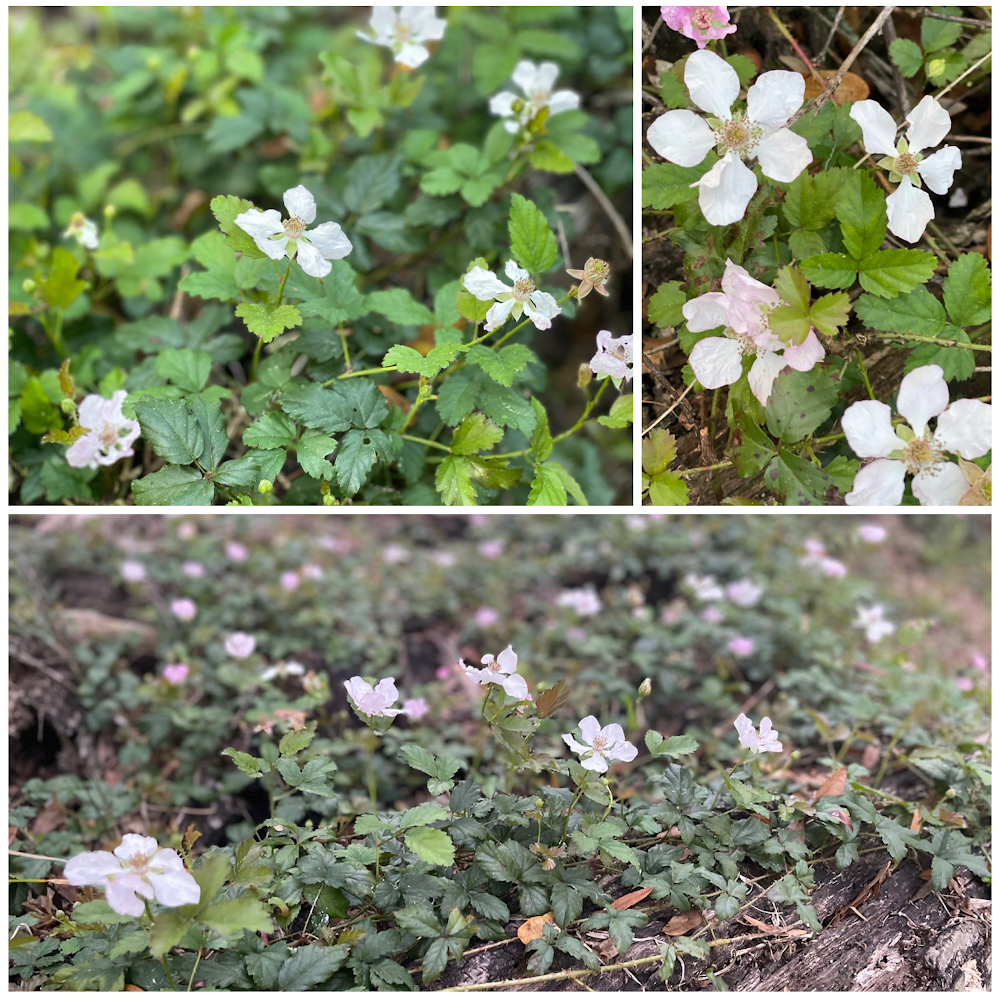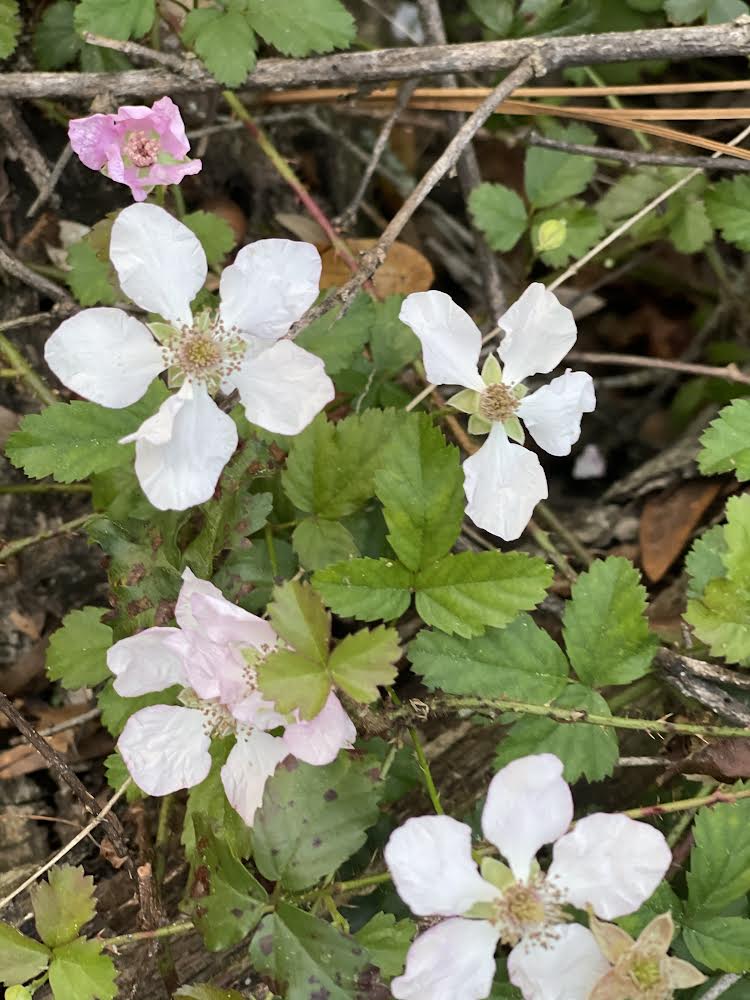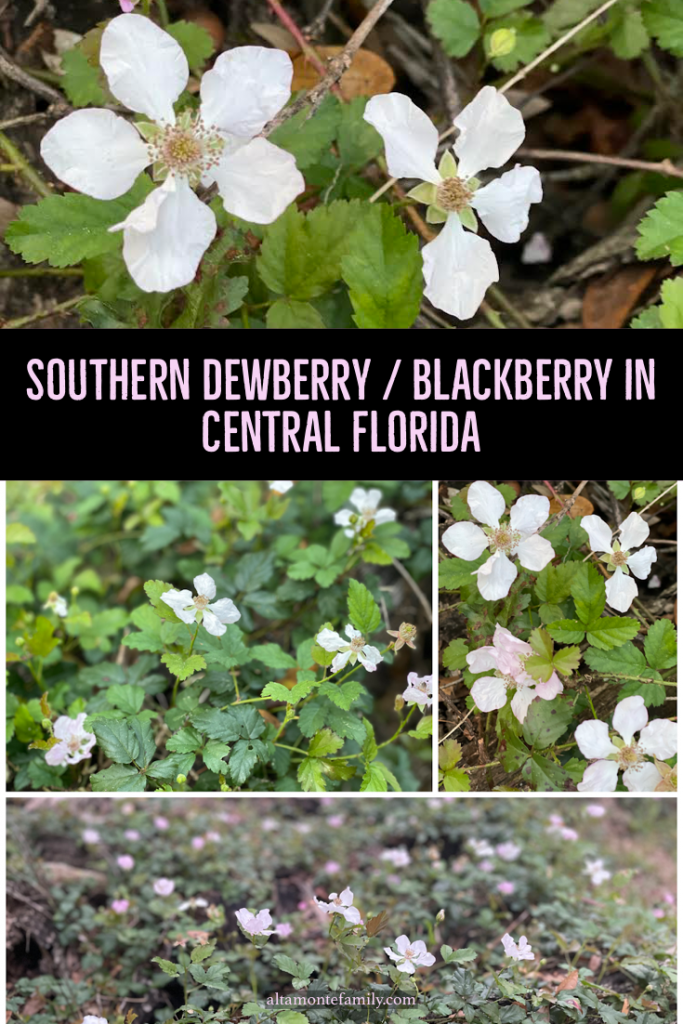I never thought I’d learn so much about all sorts of native plants until we moved to a property by the forest’s edge. After adding more native plants to our backyard, more and more birds started visiting, resulting in many surprise plants sprouting around our property. Last year, these birds planted something new, which is why we are writing about the Southern Dewberry in Central Florida, in today’s blog post.

Southern Dewberry in Central Florida
Around this time of year, you’ll probably encounter these pretty pink / white flowers along your hikes, along roadsides and ditches, and perhaps even on your property (especially if you live on acreage, near the forest’s edge or nature preserve, or near a vacant, wooded lot). These blooms belong to the Southern Dewberry, which others sometimes refer to as, the Southern Blackberry. It grows in the wild in Central Florida.

Making Space For Wildlife
We have a corner in our backyard that we allow to grow somewhat wild, specifically for wildlife. When we had several oak trees cut down in preparation for Hurricane Irma’s landfall in 2017, we chose to leave behind one fallen tree log on our property.
A few years later, as the tree log began to decompose, we started noticing a variety of birds visiting our backyard: the resident cardinal couple (of course), a variety of woodpeckers, Carolina wren, titmouse (is the plural form, titmice?), chickadees, northern parulas, many types of warblers, robins, tanagers, mockingbirds, hummingbirds, mourning doves, and more. I’m sure adding a birdfeeder at the start of the pandemic had a lot to do with attracting all these birds to our property.
Finding Voluntary Southern Dewberry Plants Gifted By Wildlife
While we don’t leave the birdfeeder up for long periods of time, the birds have chosen to stick around. They look for food here — to include seeds, fruit, bugs, worms, and nectar (for the hummingbird). In return, they give back seeds from their foraging. Most of those seeds often turn into plants that we don’t necessarily want but we just couldn’t resist to “wait and see” what they might be, until we can truly identify and observe them. This isn’t ideal for many residential properties (and especially if you’re not closely paying attention to what’s growing in your backyard).
Observing Southern Dewberry Growth Habits And Purpose
We started seeing blooms of pink / white flowers with leaves that somewhat remind us of some type of berry plant. In a nearby hiking trail, we’ve found some blackberries in the wild, but they were growing on upright stems, not on a rambling thicket. We waited another month and observed that the flowers had lost their petals and turned into immature fruit (like a raspberry of sorts). Another month or so later, they turned red and black, a litter bigger than a raspberry and a little smaller than the commercial type of blackberry. By now, the birds have been feasting on them, especially the very determined Carolina wren.

Using Southern Dewberry As A Food Source For Wildlife
While there are several Rufus (blackberry and dewberry) species found throughout the southeastern United States, these are commonly known as the Southern Dewberry. Known as a food source to wildlife in late winter (when most food sources are not readily available) through summer, you won’t be surprised to find bees and birds feasting around the fast growing thicket. In Central Florida, blooms typically start in the late winter and fruits arrive in the summer.
Managing Southern Dewberry Growing On Your Property
After allowing the Southern Dewberry to grow for a few months on our property, we decided it was time to keep it in check. Ideally, we wouldn’t want a wrangly plant like this growing in our backyard. Also ideally, we would want this plant in our backyard, solely for the purpose of ecosystem and habitat conservation, for the sake of wildlife. We don’t run around barefoot in our Florida yard, and we don’t let our children play in this designated corner.
We are now in our second year of allowing the Southern Dewberry to grow in our backyard. The birds continue to plant the seeds in different parts of our yard, and we just mow them down. It’s easy to identify the first sprout of leaves, once you’ve gotten used to seeing the plant in its different stages.
As for our little corner where the Southern Dewberry is allowed to grow, we just mow / prune along the edges (while keeping in mind to wear protective garden gear).
Removing Southern Dewberry Is Difficult
We don’t let the plant climb or tangle itself around other plants or structures. It requires quite a bit of maintenance. The lack of proper management leads to dense, difficult to control thickets that are filled with thorns. Early identification and control give you a head start, and mowing at bloom reduces seed production. However, these plants also spread via underground rhizomes, which means complete eradication is difficult (if that is your goal).
Using Chemicals With Caution
If you choose to control Southern Dewberry by means of mowing and the use of herbicides (and pollinators are a concern in your area), it may be best to apply herbicides in the fall. We don’t use herbicides as much as possible, especially since we have a variety of larval host plants to attract butterflies in our yard. One spray of the wrong herbicide will definitely kill the caterpillars. We’ve heard numerous stories of fellow butterfly gardeners whose neighbors sprayed herbicides and insecticides on a windy day, causing their caterpillars to curl up and die… in large numbers. It’s a very sad sight.
Looking For More Solutions?
If you’re looking for more specific ways to get rid of Southern Dewberry growing in your Central Florida yard, contact the local Extension Office in your county.

Leave a Reply